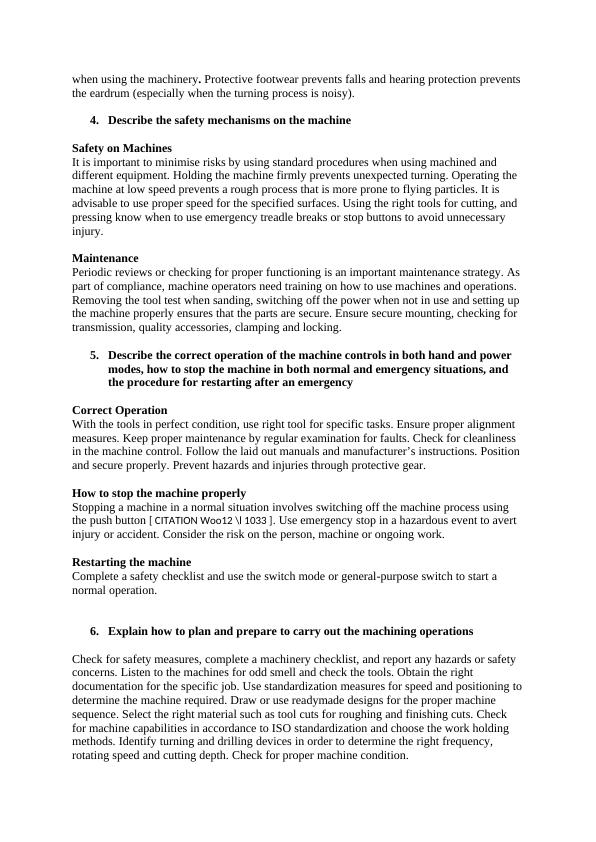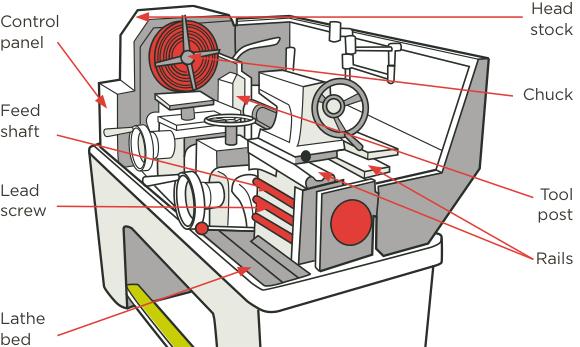Describe the Hazards Associated With the Turning Operations
What are the hazards associated with the turning operations and how can they be minimised Such as moving parts of machinery or airborne and hot metal particles or sharp cutting tools and sharp edges. Guidance on this page provides examples of the main hazards and risks while using a metal turning lathe.

Lathe Machine Hazards Download Scientific Diagram
Machining is a very common and versatile manufacturing process.

. K2 the hazards associated with the turning operations such as revolvingmoving parts of machinery airborne and hot metal particles sharp cutting tools and burrs and sharp edges on components and how they can be minimised K3 the personal protective equipment PPE to be worn for the turning. A workpiece secured in a chuck is turned against a tool which cuts metal from the workpiece. 3 Describe the hazards associated with the hand fitting activates such as use of power tools trailing leads or hoses damaged or badly maintained tools and equipment using files with damaged or poor fitting handles and how they can be minimised.
Regular maintenance can also prevent their sudden and unexpected failure. Often the workpiece will be turned so that adjacent sections have different diameters. Thus its possible to machine various types of material using these three methods.
Dust particles also hurt sensitive parts of a body like eyes and nose. Describe the hazards associated with the turning operations such as revolvingmoving parts of machinery airborne and hot metal particles sharp cutting tools and burrs and sharp edges on component and how they can be minimised 3. Is when long hair or loose clothing can be caught and dragged inwards towards the machine.
It also includes a list of recommended controls. Hazards during maintenance What is maintenance. We cover three of the most common operations including turning drilling and milling.
K6 the hazards associated with operating centre lathes and carrying out the turning operations and how to minimise them and reduce any risks K7 the importance of keeping the work area clean and tidy K8 where to obtain the component drawings specifications andor job instructions required for the components to be machined. Describe the personal protective equipment to be worn for the turning activities such as. Metal turning lathes have been associated with fatalities and serious injuries and both experienced and inexperienced operators have been hurt while operating lathes.
This can lead to critical injuries or death. There are many hazards associated with the turning operations. Many occur due to lathe activities such as entanglement.
Describe the hazards associated with the turning operations Hazards Sharp parts or edges cause cuts and loose flying particles can prick or cut users and people around. In machining several operations occur in a planned sequence to achieve the best results. Describe the hazards associated with the repairrestoration operations being carried out such as sawing hand band drilling reaming grinding hand or machine filing scrapping or lapping threading internal or external turning milling and thermal processes and how to minimise these and reduce any risks Answer.
City Guilds Level 3 NVQ Extended Diploma in Engineering Technical Support 1786 89 the machine 22 Describe the hazards associated with the turning operations such as revolvingmoving parts of machinery airborne and hot metal particles sharp cutting tools and burrs and sharp edges on component and how they can be minimised 23 Describe the. Turning is used to reduce the diameter of the workpiece usually to a specified dimension and to produce a smooth finish on the metal. Hazards and risks associated with manual handling in the workplace.
Metal turning lathes particularly centre or engine lathes are commonly used for machining metal parts. 22 Describe the hazards associated with the turning operations such as revolvingmoving parts of machinery airborne and hot metal particles sharp cutting tools and burrs and sharp edges on component and how they can be minimised 23 Describe the Personal Protective Equipment PPE to be worn for the. Turning is the removal of metal from the outer diameter of a rotating cylindrical workpiece.
Involves awkward postures or movements Working with a bent andor twisted trunk raised arms bent wrists a bent neck and turned head increases the risk of back injury and should be. Parts are created by turning the workpiece in one or both ends of the lathe and changing its shape using tools with specific. What are the hazards associated with the turning operations and how can they be minimised Such as moving parts of machinery or airborne and hot metal particles or sharp cutting tools and sharp edges.
Nothing attached QPEO2011N 2 Describe the hazards associated with the turning operations such as revolvingmoving parts of machinery airborne and hot metal particles sharp cutting tools and burrs and sharp edges on component and how they can be minimised Hazards related to lathe work are always therefore we have to be very careful when mounting our workpiece in. Describe the hazards associated with the turning operations such as revolvingmoving parts of machinery airborne and hot metal particles sharp cutting tools and burrs and sharp edges on component and how they can be minimised Loose items from clothing or long hair should be tightened as this could cause it getting caught to machinery and cause injury or even death. K2 the hazards associated with the turning operations such as revolvingmoving parts of machinery airborne and hot metal particles sharp cutting tools and burrs and sharp edges on component and how they can be minimised K3 the personal protective equipment PPE to be worn for the turning.
Working speed is imposed by a process which cannot be altered by the worker. In this context maintenance simply means keeping the workplace its structures equipment machines furniture and facilities operating safely while also making sure that their condition does not decline.


Comments
Post a Comment